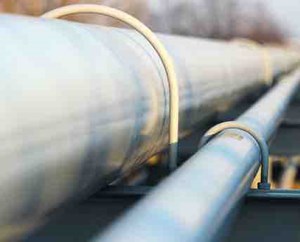November 2022 Vol. 77 No. 11
Washington Watch
Washington Watch: INGAA Opposes New Pipeline Safety Mandates

Stephen Barlas | Washington, D.C. Editor
(UC) — Interstate gas pipelines will have nine months to comply with some of the significant new safety regulations from the Pipeline and Hazardous Materials Safety Administration (PHMSA). The agency has been working on these rules for a decade ever since the San Bruno, Calif., gas explosion on a PG&E pipeline in 2010, which killed eight people.
Previously, PHMSA issued two post-San Bruno rules. One in October 2019 had to do with maximum allowable operating pressure (MAOP) reconfirmation and material properties verification, the expansion of integrity assessments beyond high-consequence areas (HCA), and a few miscellaneous things. The second final rule came out in 2021 and affected only gathering lines.
A third new rule has lots of technical tentacles, some of which pipeline companies and the Interstate Natural Gas Association of America (INGAA) opposed in the proposal stage. INGAA staff and industry officials, such as Darral Ward of Boardwalk Pipelines, manager of pipeline safety, and Eric Taylor, BHE GT&S, manager of pipeline safety group, held two meetings with PHMSA officials, prior to deciding what issues to include in a petition of reconsideration INGAA submitted on Sept. 23.
PHMSA officials, led by John A. Gale, director, office of standards and rulemaking, agreed to issue clarifying guidance, in the future, in the form of answers to frequently asked questions about several issues raised.
An INGAA spokesman says the group is strongly supportive of the just-published gas transmission final rule, but argues the nine-month effective date is inconsistent with pipeline safety, impractical and unreasonable.
“The rule, as written, does not follow GPAC recommendations that had the input of representatives of the public, state regulators and industry,” he stated. GPAC is the PHMSA’s Gas Pipeline Advisory Committee.
The 30-page petition submitted to PHMSA is signed by INGAA’s Ben Kochman, director of pipeline safety policy, and Dave Murk, director of pipelines at the American Petroleum Institute. It asks that PHMSA give transmission companies 18 months, instead of nine, to comply with the rule’s provisions, especially given other new requirements recently imposed.
Citing the new Valves Final Rule, which became effective Oct. 5, 2022, and requires compliance by April 10, 2023, the petition argues, “Imposing a nine-month compliance schedule, which was not subject to notice and comment, and requiring operators to rush compliance efforts does a disservice to the goal of promoting pipeline safety and is not practicable or reasonable.”
The new post-San Bruno rule spans a broad range of safety issues and includes new requirements for data integration in the context of threat assessments regarding risks to pipelines when a company conducts integrity management (IM) procedures.
Operators must consider 26 specific data elements. All “pertinent” elements have to be integrated into risk assessments by May 24, 2023, and all “available” attributes by Feb. 26, 2024. One-year extensions of those deadlines can be granted if a company submits a “reasonable and technically justified” explanation and states whatever temporary measures for safety are being put in place.
PHMSA is also explicitly requiring that operators integrate analyzed information into their IM programs, and that data be verified and validated. Its rationale is that “many operators have not substantially improved their risk assessment techniques or models since the early initial efforts to prioritize baseline assessment plans in 2004, with the findings from the PG&E incident being a prime, national example.”
The objective is for transmission lines to achieve a “more detailed and comprehensive” program, as discussed in the 2003 IM rule. Operators will have 18 months to “upgrade their risk assessment models, methodologies and analyses.”
The final rule also extends a Management of Change (MOC) process to non-high-consequence-area pipelines. That addition is meant to prevent a situation like the San Bruno incident, where a substandard segment of pipe was substituted without proper authorization.
The costs – PHMSA estimates at $17 million a year – reflect improvements made to the MOC process, additional corrosion control requirements, provisions related to inspections following extreme weather events, and changes made to the repair criteria.
During the proposal stage, INGAA expressed concern that the provisions were more prescriptive than the ASME/ANSI standard referenced in the current IM requirements. INGAA also commented that PHMSA’s proposed inclusion of specific attributes from ASME/ANSI B31.8S in the regulatory text, alongside the existing incorporation by reference of that standard, could cause confusion.
INGAA further stated that PHMSA should retain the current regulatory language requiring operators to “consider” the relevant data for covered segments (e.g., high-consequence areas) and similar non-covered segments, instead of adopting the proposed provisions that would require data evaluation for non-covered segments.
The final rule contains a detailed discussion of when pipeline cracks must be repaired and divides that schedule into four categories, based on the defect being above or below some percentage of MAOP. For example, Category 3: Predicted Failure Pressure (PFP) is above 110 percent and below 125 percent MAOP; Category 4: PFP is below 110 percent MAOP. Operators can use an engineering analysis on cracks in Categories 1 through 2. However, any Category 3 or 4 defect below 125 percent MAOP would require immediate remediation.
A complaint in the INGAA/API petition argues that last requirement and a second new one to monitor and mitigate effects of corrosive “constituents” in a gas stream, “departed from GPAC recommendations, some of them unanimous, without providing supporting evidence or explanation.”
There are specific thresholds for repairing metal loss on pipelines in a non-high-consequence area. For example, immediate repair is required for metal loss anomalies, when calculation of the remaining strength of the pipe at that location shows a predicted failure pressure of less than or equal to 1.1 times the MAOP.
Manchin bill provided little pipeline relief
Sen. Joe Manchin’s (D-W.Va.) late-September withdrawal of his infrastructure permitting reform bill from Senate consideration probably shouldn’t cause any teeth gnashing among interstate pipeline companies hoping for a new era of pro-pipeline regulatory policy.
In that regard, the bill was a major disappointment. It neither mentioned transmission pipelines nor alleviated any of the problems they have faced at the Federal Energy Regulatory Commission (FERC), such as efforts by the Democratic majority to incorporate higher bars for approval based on greenhouse gas emissions.
As recently as mid-September the U.S. Court of Appeals for the District of Columbia heard arguments from the Center for Biological Diversity and the Sierra Club on why FERC failed to meet its obligations under the National Environmental Policy Act (NEPA) to consider “the social cost of carbon,” when approving a liquid natural gas facility and intrastate pipeline in Alaska.
The project would transport 3.9 billion cubic feet of natural gas per day produced in Alaska’s North Slope via an 800-mile pipeline to liquefaction facilities in the Kenai Peninsula. Manchin’s bill did nothing to make those kinds of environmental objections moot.
Nor does the bill even mention FERC and GHG emission considerations, much less do anything to rein in the commission under Chairman Richard Glick, whose term is up for renewal. Nor does it change the situation where states have used Clean Water Act provisions to deny permits for pipelines.
However, according to one Washington lawyer with FERC credentials and a more sympathetic view, “The proposed reforms to the Clean Water Act and provision barring an agency from delaying a decision by encouraging a sponsor of a project to withdraw or resubmit an application could be seen as helpful, as well as asking agencies to reconsider what types of projects could qualify for NEPA categorical exclusions.”
Another head scratcher was the Manchin provisions related to completion of the Mountain Valley Pipeline, which has been stymied by lawsuits related to permits from various federal regulatory agencies that have been successfully challenged by environmental groups.
Manchin’s bill essentially tells those agencies to “take all necessary actions” to finish approval of those permits and, anyone who objects to the permits’ issuance, can take the complaint to the U.S. Court of Appeals for the District of Columbia. That is the court where, earlier in 2022, a three-judge panel slapped the wrists of the Forest Service and Bureau of Land Management for issuing defective environmental impact statements.





Comments